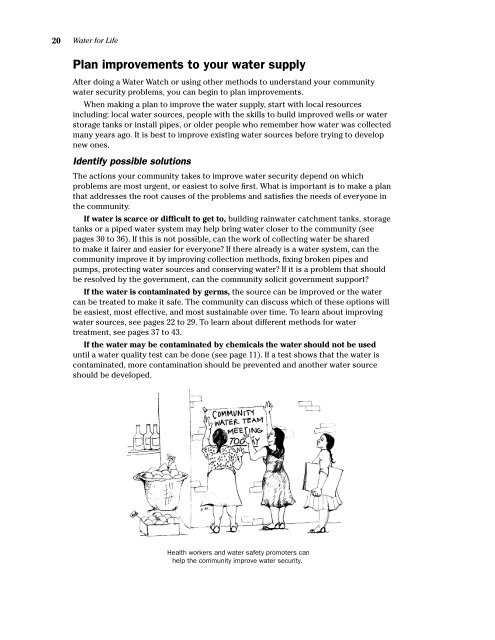Community water security - UN-Water
Community water security - UN-Water
Community water security - UN-Water
Create successful ePaper yourself
Turn your PDF publications into a flip-book with our unique Google optimized e-Paper software.
20<br />
<strong>Water</strong> for Life<br />
Plan improvements to your <strong>water</strong> supply<br />
After doing a <strong>Water</strong> Watch or using other methods to understand your community<br />
<strong>water</strong> <strong>security</strong> problems, you can begin to plan improvements.<br />
When making a plan to improve the <strong>water</strong> supply, start with local resources<br />
including: local <strong>water</strong> sources, people with the skills to build improved wells or <strong>water</strong><br />
storage tanks or install pipes, or older people who remember how <strong>water</strong> was collected<br />
many years ago. It is best to improve existing <strong>water</strong> sources before trying to develop<br />
new ones.<br />
Identify possible solutions<br />
The actions your community takes to improve <strong>water</strong> <strong>security</strong> depend on which<br />
problems are most urgent, or easiest to solve first. What is important is to make a plan<br />
that addresses the root causes of the problems and satisfies the needs of everyone in<br />
the community.<br />
If <strong>water</strong> is scarce or difficult to get to, building rain<strong>water</strong> catchment tanks, storage<br />
tanks or a piped <strong>water</strong> system may help bring <strong>water</strong> closer to the community (see<br />
pages 30 to 36). If this is not possible, can the work of collecting <strong>water</strong> be shared<br />
to make it fairer and easier for everyone? If there already is a <strong>water</strong> system, can the<br />
community improve it by improving collection methods, fixing broken pipes and<br />
pumps, protecting <strong>water</strong> sources and conserving <strong>water</strong>? If it is a problem that should<br />
be resolved by the government, can the community solicit government support?<br />
If the <strong>water</strong> is contaminated by germs, the source can be improved or the <strong>water</strong><br />
can be treated to make it safe. The community can discuss which of these options will<br />
be easiest, most effective, and most sustainable over time. To learn about improving<br />
<strong>water</strong> sources, see pages 22 to 29. To learn about different methods for <strong>water</strong><br />
treatment, see pages 37 to 43.<br />
If the <strong>water</strong> may be contaminated by chemicals the <strong>water</strong> should not be used<br />
until a <strong>water</strong> quality test can be done (see page 11). If a test shows that the <strong>water</strong> is<br />
contaminated, more contamination should be prevented and another <strong>water</strong> source<br />
should be developed.<br />
Health workers and <strong>water</strong> safety promoters can<br />
help the community improve <strong>water</strong> <strong>security</strong>.
















